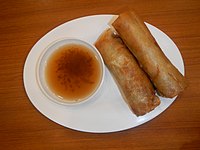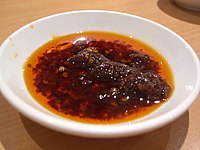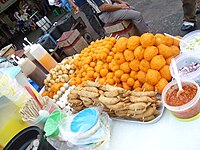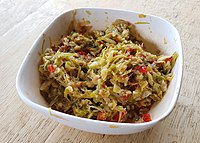Philippine condiments
The generic term for condiments in the Filipino cuisine is sawsawan (Philippine Spanish: sarsa). Unlike sauces in other Southeast Asian regions, most sawsawan are not prepared beforehand, but are assembled on the table according to the preferences of the diner.[1]
Description
In the Philippines, the common condiments aside from salt and pepper are vinegar, soy sauce, calamansi, and patis. The combination and different regional variations of these simple sauces make up the various common dipping sauces in the region.
The most common type of sawsawan is the
A similar dipping sauce used for grilled meats like
The simplest dipping sauce, for example, is vinegar mixed with another ingredient like siling labuyo (sukang may sili), garlic (suka't bawang), soy sauce (sukang may toyo), and so on. This can be elaborated further by adding a range of spices and even fruits, resulting in dipping sauces like
All of these do not have set recipes, however, and can use ingredients and proportions interchangeably according to what is available and to the preference of the diner.
Other notable ingredients added to these kinds of sawsawan include
Some sauces need to be prepared beforehand like the traditional Filipino
Another spicy condiment used for street food is the "
Among the Maranao people, another notable condiment is the palapa, a very spicy condiment made from sakurab (native scallions), ginger, turmeric, and chilis. It is an ubiquitous accompaniment to Maranao meals.[16][17]
For seafood dishes, another common condiment is
List of Philippine condiments
The following is a list of condiments used in Filipino cuisine.
| Name | Image | Description |
|---|---|---|
Agre dulce
|

|
A sweet and sour sauce made from cornstarch, salt, sugar, and tomato or banana ketchup. |
| Asado sauce | A sauce made from the leftover boiling liquid of asado. Commercial brands use a mixture of pineapple juice, soy sauce, and sugar with cornstarch as a thickener. Served as a sauce for siopao. | |
| Banana ketchup | 
|
A sweet, red condiment made primarily of bananas . Has a sweet, tangy taste without the sourness of tomato ketchup.
|
| Chili garlic sauce | 
|
Similar to Chinese chili oil, a condiment of minced |
| Ketchup and mayonnaise sauce | A combination of mayonnaise and banana ketchup. Similar to tomato ketchup .
| |
| Lechon sauce | 
|
Also known as liver sauce, breadcrumb sauce, and all-around sauce. A sweet, tangy, light-brown sauce used as dipping sauce for roasted and fried dishes, especially lechon and lechon kawali . Made from ground liver or liver pâté, vinegar, sugar, and spices.
|
| Manong's sauce/Fishball sauce | 
|
Literally 'Mister's sauce'. A dipping sauce made from sugar, soy sauce, garlic, and carbonated soft drinks. Used as a dipping sauce for deep-fried street foods like fishball and fried isaw
|
| Palapa | 
|
A spicy Maranao condiment consisting of finely chopped sakurab (white scallions), ginger, chilis like siling labuyo, and grated coconut cooked briefly and stored. It can also be dried. It is usually sautéed before using, or added as an ingredient to other dishes.[20] |
| Suka Pinakurat | A popular brand of spiced natural coconut sap vinegar from Iligan City, Mindanao. It is a natural vinegar of fermented coconut sap (tubâ) blended with siling labuyo (kulikot) and other spices.
| |
| Sarsang miso/Miso guisado | A sauce made from miso stir-fried with minced garlic, diced tomatoes, vinegar, and ground black pepper.[10] | |
| Sarsang talong | Literally 'eggplant sauce'. A sour condiment made from grilled eggplants, garlic and vinegar. Used as an accompaniment to cocidos.[10] | |
| Sinamak | 
|
Vinegar of Visayan origin. Made with chilis (commonly siling labuyo), langkawas, garlic, peppercorns, and white onion pickled for at least three days.[21]
|
| Sukang may sili | 
|
Cane or coconut labuyo peppers. Usually served as an accompaniment to grilled dishes, especially barbecue on a stick.
|
| Suka at toyo | Cane or coconut labuyo peppers or diced onions, especially as an accompaniment to grilled meats (inihaw) and crispy pata.[2]
| |
| Toyo't kalamansi | 
|
Sometimes referred to simply as kalamansi lime juice.
|
Pickles and fermented sauces

- Atchara - The method of pickling in a vinegar solution, usually a sweet pickling solution. By itself refers to the sweet pickled relish of unripe papaya. Used as a side dish, especially with grilled and fried meat and seafood.[22]
- Atcharang maasim (sour pickles)
- Atcharang labóng (pickled bamboo shoots)
- Atcharang dampalit (pickled sea purslane)
- Atcharang ubod (pickled palm hearts)
- Atcharang sayote (pickled chayote)
- Ensaladang mangga - green mango relish with tomatoes and onions.
- binagoongang kangkong.
- Buro, tapay - fermented rice, which can use red yeast rice (angkak). Used mainly as a condiment for steamed/boiled vegetables like okra, sweet potato leaves (talbos ng kamote), eggplant, etc.
- Balao-balao - fermented rice with shrimp
- Burong isda - fermented rice with fish
- bagoong alamang(shrimp paste)
- Burong mustasa - pickled mustard leaves
- Tinapayan - fermented rice with dried fish
- kalamansi limejuice, in which case it is called patismansi.
- Taba ng talangka - fermented paste derived from the salted roe and aligue (reddish or orange crab "fat") of the river swimming crabs (talangka). Can be sautéed in garlic and preserved in oil.
Dessert sauces
- Arnibal - syrup made from sugarcane molasses or palm sugar (panutsa)
- Visayanusage only) a thick syrup made from coconut milk and sugar.
Flavoring ingredients and seasonings

- Achuete (Annatto oil) - annatto seeds fried in oil which typically turn dishes a bright orange
- Asín tibuok
- Biasongor samuyao (small-fruited papeda)
- Kamias(bilimbi)
- Kasubha (safflower)
- Dayap
- Kiamoy powder
- Kunig or luyang dilaw (turmeric)
- Langkawas(galangal ginger)
- Tanglad(lemongrass)
- Dungon
- Pandan
- Calamansi - small Philippine limes
- Sakurab (sibujing)
- Siling labuyo - small native chili cultivar
- Tabon-tabon
See also
References
- ^ a b c "How to make the Best Sweet Spicy Sawsawan". Ang Sarap. Retrieved July 10, 2019.
- ^ a b "Toyo, Suka, at Sili". Maputing Cooking. Retrieved July 10, 2019.
- ^ a b "What's Your Favorite Sawsawan???". Market Manila. Retrieved July 11, 2019.
- ^ "suka pinakurat - Home". Archived from the original on October 12, 2007.
- ^ "Homemade Pinakurat". Mama's Guide Recipes. Retrieved July 10, 2019.
- ^ "Recipe: Sawsawang Toyo at Inihaw na Bangus, Tuna Belly at Ulo ng Salmon". Idol sa Kusina. GMA Network. Retrieved July 11, 2019.
- ^ "S is for Sawsawan". Junblog. Retrieved July 11, 2019.
- ISBN 9780399511448.
- ^ "Sweet and Sour Sauce (Agre Dulce)". Kusina ni Manding. Retrieved July 9, 2019.
- ^ ISBN 9781462905454.
- ^ "Fishball Sauce Recipe". Foxy Folksy. Retrieved July 11, 2019.
- ^ "Fishballs Sauce ala Manong's Sauce Recipe". Atbp.ph. Retrieved July 11, 2019.
- ^ "Filipino Street Food: Fishball Sauce Recipe". Maputing Cooking. Retrieved July 11, 2019.
- ^ "Fish Ball Sauce Recipe, Just Like Manong's". Certified Foodies. Retrieved July 11, 2019.
- ^ a b "How to make Homemade Siomai Sauce". Mama's Guide Recipes. Retrieved July 10, 2019.
- ^ Santos, Kara (September 27, 2018). "Home > Life Maranao condiment 'palapa' offers recipe for hope". ABS-CBN News. Retrieved March 5, 2019.
- ^ Morocco, Chris. "This Condiment Is Sweet, Spicy, Garlicky and Just Ridiculously Good". Healthyish. Bon Appétit. Retrieved March 5, 2019.
- ^ "Shrimp with Butter and Taba ng Talangka Recipe – Bisita Kusina Episode 2". Panlasang Pinoy. Retrieved July 11, 2019.
- ^ Baes, Patricia. "Cole, Navarro's Regular, and Lorins: 3 Budget-Friendly Taba ng Talangka". Pepper.ph. Retrieved July 11, 2019.
- ^ Polistico, Edgie. "Palapa". Philippine Food Illustrated. Retrieved March 5, 2019.
- ^ "How to Make Sinamak". Panlasang Pinoy. Retrieved July 11, 2019.
- ISBN 978-971-23-2157-3.


